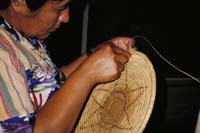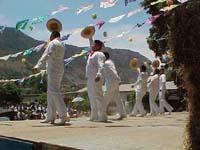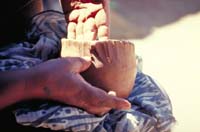|
 The
rich cultural heritage of the Baja California peninsula has been shaped
by its unique geography and ecosystems, a history of isolation and migration,
and peoples as rugged and tenacious as the land itself. For the vast majority
of human history in the peninsula, native populations have adapted their
lives to the arid climate and its coastal, desert and mountain habitats
through annual cycles of hunting, gathering and fishing. Like other foraging
groups, they were often organized in highly mobile extended family bands.
Their material culture was simple enough to be packed in a fiber carrying
net and moved as different resources-pitaya cactus fruit, acorns, shellfish,
deer, just to name a few-came into season. Early accounts describe a diversity
of cultures with different languages, oral tradition, religious beliefs,
styles of dress, personal ornamentation, diet and customs. The
rich cultural heritage of the Baja California peninsula has been shaped
by its unique geography and ecosystems, a history of isolation and migration,
and peoples as rugged and tenacious as the land itself. For the vast majority
of human history in the peninsula, native populations have adapted their
lives to the arid climate and its coastal, desert and mountain habitats
through annual cycles of hunting, gathering and fishing. Like other foraging
groups, they were often organized in highly mobile extended family bands.
Their material culture was simple enough to be packed in a fiber carrying
net and moved as different resources-pitaya cactus fruit, acorns, shellfish,
deer, just to name a few-came into season. Early accounts describe a diversity
of cultures with different languages, oral tradition, religious beliefs,
styles of dress, personal ornamentation, diet and customs.
 With
the Spanish conquest of the Californias beginning some 450 years ago,
this way of life would change drastically as native peoples had to adapt
to the presence of Jesuit, Franciscan and Dominican missionaries, Spanish
military and settlers. Indigenous people responded to these changes in
a variety of ways, some of them seeking refuge in remote areas where they
continued their hunting and gathering way of life, some mixing in with
the new populations, some adding livestock ranching and agriculture to
their adaptive strategies. With
the Spanish conquest of the Californias beginning some 450 years ago,
this way of life would change drastically as native peoples had to adapt
to the presence of Jesuit, Franciscan and Dominican missionaries, Spanish
military and settlers. Indigenous people responded to these changes in
a variety of ways, some of them seeking refuge in remote areas where they
continued their hunting and gathering way of life, some mixing in with
the new populations, some adding livestock ranching and agriculture to
their adaptive strategies.
 The
influences of this common heritage and history have shaped the culture
of Baja California's four surviving native groups. Approximately 1000
Native Baja Californians live in eight indigenous communities of the northern
peninsula: the Kumiai in Juntas de Nejí, San Jose de la Zorra,
San Antonio Necua and La Huerta; the Paipai in Santa Catarina and San
Isidoro; the Cucapá in El Mayor Cucapá and the Kiliwa in
Ejido Tribu Kiliwas. These groups all belong to the Yuman family of closely-related
languages and cultures, a family that includes other groups of Southern
California and Arizona. The
influences of this common heritage and history have shaped the culture
of Baja California's four surviving native groups. Approximately 1000
Native Baja Californians live in eight indigenous communities of the northern
peninsula: the Kumiai in Juntas de Nejí, San Jose de la Zorra,
San Antonio Necua and La Huerta; the Paipai in Santa Catarina and San
Isidoro; the Cucapá in El Mayor Cucapá and the Kiliwa in
Ejido Tribu Kiliwas. These groups all belong to the Yuman family of closely-related
languages and cultures, a family that includes other groups of Southern
California and Arizona.
 Today,
the cultural landscape of the Baja California peninsula includes: Today,
the cultural landscape of the Baja California peninsula includes:
- the Kumiai, Paipai, Cucapá and Kiliwa Indians, descendents
of the Yuman indigenous groups;
- the Rancheros or Californios, living in isolated ranches and rural
towns, descendents of the early Spanish settlers and their indigenous
neighbors;
- indigenous groups originally from other parts of Mexico, including
Yaqui, Mayo, Mixtec, Zapotec, Triqui, Nahuatl and other groups who have
migrated to the peninsula primarily during the last century;
- descendents of Spanish, Basque, French, Italian, Russian, German,
English, Chinese, North American and other settlers whose surnames can
still be found in the farthest reaches of the peninsula;
 mestizos
from both urban and rural areas of the Mexican mainland; mestizos
from both urban and rural areas of the Mexican mainland;- urban populations of the peninsula's cities
- fishing villages
- transborder communities (living in Mexico, working in the U.S.); and
- the Baja California norteño, a hybrid of several of the previous
categories.
Cultural anthropological studies in Baja California have focused primarily
on the first category, the native indigenous populations. Due to the tragic
extinction of the indigenous groups of the central and southern  peninsula,
written accounts of those groups can only be found in the pre-ethnographic
documents of the Jesuit, Franciscan and Dominican missionaries as well
as occasional European explorers and military expeditions (see History).
Ethnographic and ethnological reports on the Yuman groups begin in the
twentieth century with the works of Peveril Meigs III, William Hohenthal,
William Kelly, Frederic Noble Hicks, Roger C. Owen, Ralph Michelsen, Anita
Álvarez Williams, Mauricio Mixco, Julia Bendímez, Don Laylander,
Michael Wilken, Everardo Garduño, Mario Alberto Magaña Mancillas,
Jesus Angel Ochoa Zazueta, and Paul Campbell. peninsula,
written accounts of those groups can only be found in the pre-ethnographic
documents of the Jesuit, Franciscan and Dominican missionaries as well
as occasional European explorers and military expeditions (see History).
Ethnographic and ethnological reports on the Yuman groups begin in the
twentieth century with the works of Peveril Meigs III, William Hohenthal,
William Kelly, Frederic Noble Hicks, Roger C. Owen, Ralph Michelsen, Anita
Álvarez Williams, Mauricio Mixco, Julia Bendímez, Don Laylander,
Michael Wilken, Everardo Garduño, Mario Alberto Magaña Mancillas,
Jesus Angel Ochoa Zazueta, and Paul Campbell.
Important contributions to the study of indigenous cultures appear in
the special Baja California editions of the Pacific Coast Archaeological
Society Quarterly while recent news of the contemporary communities can
be found in the CUNA Newsletter (Native Cultures Institute of Baja California).
© 2002 Michael Wilken-Robertson
|

